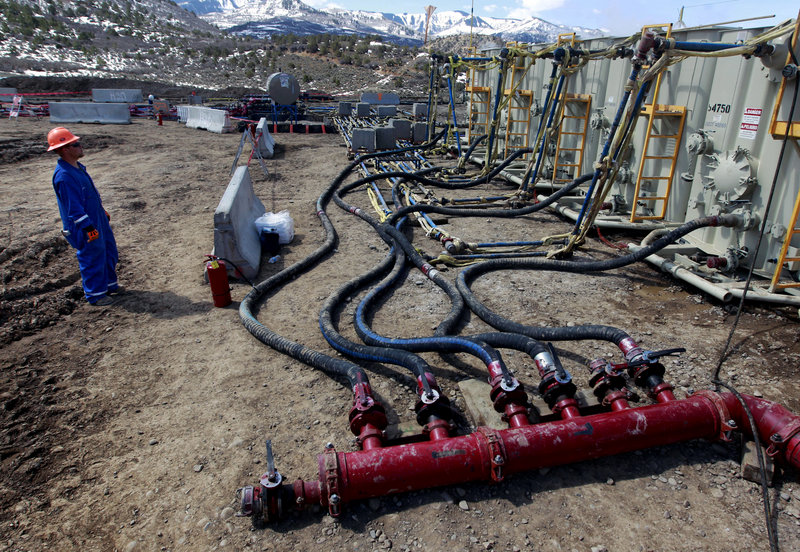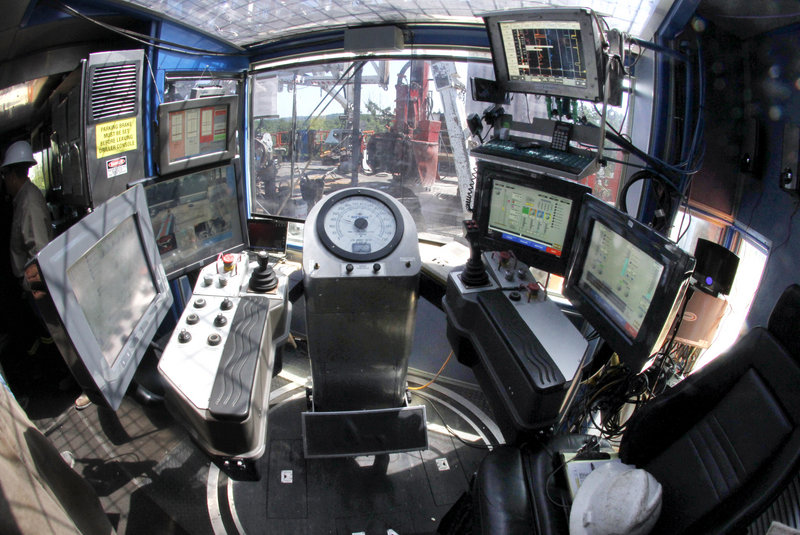Technology created an energy revolution over the past decade — just not the one we expected.
By now, cars were supposed to be running on fuel made from plant waste or algae — or powered by hydrogen or cheap batteries that burned nothing at all. Electricity would be generated with solar panels and wind turbines. When the sun didn’t shine or the wind didn’t blow, power would flow out of batteries the size of tractor-trailers.
Fossil fuels? They were going to be expensive and scarce, relics of an earlier, dirtier age.
But in the race to conquer energy technology, Old Energy is winning.
Oil companies big and small have used technology to find a bounty of oil and natural gas so large that worries about running out have melted away. New imaging technologies let drillers find oil and gas trapped miles underground and undersea. Oil rigs “walk” from one drill site to the next. And engineers in Houston use remote-controlled equipment to drill for gas in Pennsylvania.
The result is an abundance that has put the United States on track to become the world’s largest producer of oil and gas in a few years. Just Thursday, the U.S. reported that oil imports have fallen to a 17-year low.
The gushers aren’t limited to Texas, North Dakota and the deep waters of the Gulf of Mexico. Overseas, enormous reserves have been found in East and West Africa, Australia, South America and the Mediterranean.
“Suddenly, out of nowhere, the world seems to be awash in hydrocarbons,” says Michael Greenstone, an environmental economics professor at the Massachusetts Institute of Technology.
The consequences are enormous. A looming energy crisis has turned into a boom. These additional fossil fuels are intensifying the threat to the earth’s climate. And for renewable energy sources, the sunny forecast of last decade has turned overcast.
This is the story of how technological advances drove a revolution no one in the energy industry expected. One that is just beginning.
THE RACE FOR NEW TECHNOLOGY
But while the national focus was on alternatives, the oil and gas industry was innovating too. New technology allowed drillers to do two crucial things: find more places where oil and gas is hidden and bring it to the surface economically.
Large oil companies such as Exxon, Chevron, Shell and BP turned up huge discoveries offshore in ultra-deep water with the help of better sensors and faster computers that allowed them to see once-hidden oil deposits.
Onshore, small drillers learned how to pull oil and gas out of previously inaccessible underground rock formations.
For most of the oil age, drillers have looked for large underground pools of oil and gas that were easy to tap. These pools had grown over millions of years as oil and gas oozed out of what is known as source rock. Source rock is a wide, thin layer of sedimentary rock — like frosting in the middle of a layer cake — that is interspersed with oil and gas.
An engineer named George Mitchell and his company, Mitchell Energy, spent years searching for a way to free natural gas from this source rock. He finally succeeded when he figured how to drill horizontally, into and then along a layer of source rock. That allowed him to access the gas throughout a layer of source rock with a single well. Then he used a process known as hydraulic fracturing, or “fracking” to create tiny cracks in the rock that would allow natural gas to flow into and up the well.
The United States, which was facing a gas shortage five years ago, now has such enormous supplies it is looking to export the fuel in large volumes for the first time.
SMART DRILLS, RIGS THAT CAN WALK
But even after drillers figured out how to find oil and gas deep offshore and in onshore source rock, they still needed to develop technology that would make it economical.
At the tip of every oil or gas drill is a rotating mouth of sharp teeth that chews through rock. In the past, these drill bits could only dig straight down. Now they are agile enough to find and follow narrow horizontal seams of rock.
The drilling-services company Baker Hughes has designed a bit that can change directions underground, without having to be drawn back up to the surface, reducing drilling time by as much as 40 percent.
Behind the drill bit, attached to a long line of steel known as the “drill string,” is an array of sensors. The sensors bombard rock with subatomic particles and measure the gamma radiation that bounces back. They assess how easily electricity flows through the rock and underground fluids. They analyze the magnetism of the rock and how it vibrates — both up and down and side to side — while drilling.
“To the layman, it looks like dumb iron, but you’d be shocked about what’s inside,” says Art Soucy, president of global products and services at Baker Hughes.
All this information is sent to engineers via fiber-optic cables. They run the information through supercomputers as powerful as 30,000 laptops to create a picture of the earth thousands of feet below the surface.
The people analyzing this data — and even directing the drill bits — are often sitting hundreds of miles away. Shell’s Pennsylvania drilling operations are directed from a center in Houston, where experienced drillers monitor the progress at several sites across the country from a single room.
And when the drilling is done, the rig itself can “walk” a hundred feet or so to another location and start drilling again. In the past, rigs had to be taken down and reassembled, which could take days. New rigs are built on sliding “shoes” that allow hydraulic lifts to shuffle the rig forward in short steps.
“It has made possible things that were unthinkable 10 years ago,” says Claudi Santiago, managing director at First Reserve Corp., a private-equity firm that invests in energy companies.
Now, drillers are finding oil faster than the world is using it. At the end of 2001, the industry had enough “proved oil reserves” to satisfy world demand for 45 years, according to BP’s annual statistical review, a closely watched study. By the end of 2011 that had grown to 51 years — even though a decade’s worth of oil had been used and daily demand had grown 14 percent. And “proved reserves” refers to oil that can be economically tapped using today’s technology. Tomorrow’s methods could yield even more.
This is good news for a global economy that remains dependent on fossil fuels, but it’s terrifying to climate scientists.
“If we’re willing to go down this road of squeezing whatever petroleum we can out of the earth, we can easily get carbon dioxide levels up to unfathomable levels and put in motion what would be dramatic or catastrophic changes in our climate system,” says Michael E. Mann, a geophysicist and director of the Earth System Science Center at Penn State University.
Copy the Story Link
Send questions/comments to the editors.




Success. Please wait for the page to reload. If the page does not reload within 5 seconds, please refresh the page.
Enter your email and password to access comments.
Hi, to comment on stories you must . This profile is in addition to your subscription and website login.
Already have a commenting profile? .
Invalid username/password.
Please check your email to confirm and complete your registration.
Only subscribers are eligible to post comments. Please subscribe or login first for digital access. Here’s why.
Use the form below to reset your password. When you've submitted your account email, we will send an email with a reset code.